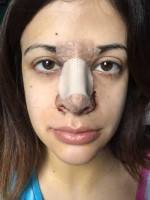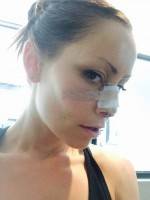Open rhinoplasty swelling
The swelling after rhinoplasty, especially if you have an open rhinoplasty can take months to completely resolve.
Having said that only you and your PS will notice the subtle swelling after 4 weeks, but it does take a while for the tip swelling to dissipate.
At 3 weeks you will be swollen, if you weren’t I would be more surprised, so my advise is to sit tight and wait. Every day it will look better. (Pouria Moradi, MBBS, FRACS, Sydney Plastic Surgeon)
Swelling after open rhinoplasty can take time to come down. Every person heals differently, and every surgery has aspects which cause more or less swelling.
My advice is to not judge your nose because it takes up to a year to see the final result, although most of the swelling comes down in the first few months. (Richard A. Zoumalan, MD, Los Angeles Facial Plastic Surgeon)
Swelling after a open rhinoplasty / nose job
SO noses unlike breasts or abdomens take a lot longer to heal. Swelling can last up to a year or year and half. The initial 80% will resolve in the first 6wks.
The final 20% may take the rest of the year. The thicker your skin the longer it takes. Many ethnic noses like Latinos or Asians take a long time.
The key is as follows. If your nose looks amazing at 2 months then it will likely look bad at 1 year when all the swelling resolves.you must be patient. (Rady Rahban, MD, Los Angeles Plastic Surgeon)
Swelling after rhinoplasty surgery
Open rhinoplasty swelling can last up to several weeks after which you can resume full activity. It’s normal for you to still experience swelling after three weeks of your surgery. Swelling occurs inside and outside of the nose and varies for each individual. To control swelling, you can use a cold compress and keep your head elevated as often as you can.
If you have any concerns, you should consult with your facial plastic surgeon. (Carlo Honrado, MD, FACS, Los Angeles Facial Plastic Surgeon)
Post Operative Swelling Following Open Rhinoplasty
A few rules of thumb with respect to swelling after rhinoplasty and the haling process overall:
- Revisions will take longer to reach their end result than primaries
- The more dissection and manipulation performed, the more acute swelling and the longer it will take for the nose to stabilize
- When the nasal bones are in fractured there is more swelling (open or closed doesn’t matter)
- Salt, alcohol, heat and having the head be in a low position relative to the heart will all create more swelling for the first several months.
- While the acute swelling might be diminished enough to allow for social interaction within 10-12 days, it will take many months to resolve entirely. During that time there will be good days and not-so-good ones and they will depend on several factors such as diet, sun exposure, heat, alcohol consumption, hormones.
- The tip and the area below the tip (infratip lobule) stay swollen the longest due to their position and lymphatic drainage from this area.
- Once the swelling resolves, the tissues contract and this changes the nose and creates more refinement. It is this process which takes the longest and that creates changes that continue for several years after surgery.
- Focal areas of swelling that are problematic can be addressed with injections of various medicines. There are risks to such treatments so they should be done only after consideration for the risk/benefits involved. (Andrew S. Frankel, MD, Beverly Hills Facial Plastic Surgeon)
Length of swelling after open rhinoplasty
The average length of swelling after open rhinoplasty surgery depends on several factors:
- Area of the nose that was worked on – the tip of the nose tends to hold onto swelling the longest and results will not be appreciated for a full year here. In contrast, the bridge of the nose has relatively thin skin and usually subsides quickly here over 3-4 months.
- Thickness of the skin – as stated previously the bridge of the nose has thinner skin and thus swelling subsides quickly here. Some patients have thicker skin especially in the tip of the nose and for these patients swelling can last longer than one year.
- Technique – open vs. closed: More manipulation and trauma is created by opening the nose (an incision is made underneath the nose and the skin is pulled away from the structure below) versus closed where incisions are placed inside the nose and the skin is not pulled back and redraped.
- Personal medical history affecting healing – Having a smoking history, a history of diabetes, or other medical problems that can affect healing will lengthen the time of recovery.
The majority of my patients see minimal bruising and swelling right after surgery but notice it more prominently after the cast has been removed. Once the cast is removed, it is not uncommon for some to feel that the nose has increased in size. The tip of the nose will also lose its defined shape and look rounded. Most of the swelling subsides over the first 1-3 months. The remainder of the swelling in the tip then subsides over one year. (Kristina Tansavatdi, MD, Los Angeles Facial Plastic Surgeon)
Swelling after rhinoplasty can be very annoying for patients. Often times I have less patience than even my own patients to see what we have really created in the nasal shaping!
However, you must trust your surgeon in that he/she knows what was created in the operating room. That is what counts.
Your surgeon should not leave the Operating Room until everything looks as good as possible. Then it is just a matter of being patient and waiting for time to pass.
Taping and massaging can help a great deal so discuss these options with your surgeon. Many ethnic patients with thick nasal skin can swell for longer and may require a customized taping, molding and steroid injection program, which I perform in my practice.
Also, males sometimes can swell more as well. Three Weeks is still too early to tell anything but as time goes by and your and your surgeon do swelling reduction post-op care, then by 6 weeks you should start to really see the shaping that will finalize over the next year. Be patient. I know it is hard. (Ashkan Ghavami, MD, Beverly Hills Plastic Surgeon)
Rhinoplasty swelling can last up to three months or more. However, final result won’t be visible until over one year. The reason is, that the skin has to contract around the underlying cartilages.
While this can occur very quickly in certain types of skin, most skin of regular thickness to very thick in nature require at least one year before the underlying contour can be revealed (Philip Miller, MD, New York Facial Plastic Surgeon)
Rhinoplasty swelling can present up to a year
Swelling after a Rhinoplasty surgery can be present up to 1 year post-surgery depending upon the extent of the procedure itself.
Generally, the majority of swelling goes away in the first 4-6 months, but it can take up to 1 year for the results of your Rhinoplasty to truly be seen properly. The main thing is to make sure your surgeon is experienced in nasal surgeries to minimize recovery issues as much as possible.
Given that you are only 3 weeks post-surgery, it is quite normal for you to be experiencing swelling still, although it should be fairly minor. If you have any concerns about the swelling, it is best to address this with your surgeon directly. (Scott W. Mosser, MD, San Francisco Plastic Surgeon)
Healing after rhinoplasty
Rhinoplasty may produce swelling that can last for a prolonged period of time. The definition of ‘prolonged’ may be different between patients and surgeons, so I always try to talk to my patients in absolute time periods.
Typically, I tell my patients that reduction of rhinoplasty swelling to a point of ‘social acceptability’ is between 1-2 weeks. Healing occurs over a long time but 70-80% of swelling will be gone by 1 month. This is especially true in the tip and the sides of the bones near the eyes if work is done on those areas. The last 20-30% will go away over the next 3-9 months and will be the time when the finer shadows and contours of the surgery will begin to appear.
Besides the specific surgery that is done, several other factors will increase swelling and healing time. Patients with thicker skin will have more swelling, which may require post-operative steroid injections to speed recovery. The more of a reduction in size, the longer the period of rhinoplasty swelling, as the skin needs to redrape and contract around a smaller structure.
Diets high in salt can add to swelling, as can sun exposure, exercise, and sleeping flat at night. All in all, 3 weeks is fairly early in the healing process. Remember that you want your result to last a life time. Since the nose heals over a long period of time, a perfect result on the day the cast is removed might mean a much smaller nose in the end than you wanted. (Richard W. Westreich, MD, Manhattan Facial Plastic Surgeon)
Rhinoplasty Post op Swelling
I tell all my patients to expect noticeable rhinoplasty swelling over the bones (the upper part of your nose) for about 4-6 weeks. The swelling in the tip, however, can persist for 12-18 months to some degree. It will be noticeable to you for that period but probably not others. It will show up in casual photos for the first 3 months. If you have thick or oily skin in particular, it can take quite a while to clear.
Sometimes surgeons use small steroid injections along the way to help with uneven swelling. (Stuart H. Bentkover, MD, Boston Facial Plastic Surgeon)
Swelling After Rhinoplasty
This is one of the more commonly asked questions about Rhinoplasty. It takes a year or more for all of the swelling to subside and that for the “result” to appear. In fact, the nose can change for up to 5 years after Rhinoplasty surgery.
Most of the swelling you will notice will be in the nasal tip. Things that are relatively apparent immediately after surgery include removal of a nasal hump, straightening of a crooked nose, and rotation of a nasal tip. (Stephen Prendiville, MD, Fort Myers Facial Plastic Surgeon)


